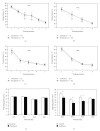Forepaw sensorimotor deprivation in early life leads to the impairments on spatial memory and synaptic plasticity in rats
- PMID: 20069062
- PMCID: PMC2804797
- DOI: 10.1155/2009/919276
Forepaw sensorimotor deprivation in early life leads to the impairments on spatial memory and synaptic plasticity in rats
Abstract
To investigate the influence of forepaw sensorimotor deprivation on memory and synaptic plasticity, Sprague-Dawley rats were divided into two groups: a sham-operated group and a group deprived of forepaw sensorimotor function by microsurgical operation at postnatal day 13 (PN13). Behavioral and electrophysiological studies were performed at PN25, PN35, PN45, and PN60. Open field test was used to assess the spontaneous locomotor activity. Morris water maze was used to evaluate spatial reference learning and memory. The long-term potentiation (LTP) in the medial perforant path--dentate gyrus (MPP-DG) pathway was examined with hippocampal slices. We found that forepaw sensorimotor deprivation did not affect spontaneous activity of the rats. However, spatial reference learning and memory were significantly impaired in their early life (PN25, PN35, and PN45). In accordance with the behavior results, LTP in MPP-DG pathway was significantly suppressed in their early life. These data demonstrated that forepaw sensorimotor deprivation led to the impairments on spatial memory via inducing pronounced deficits in the MPP-DG pathway to exhibit LTP, one of the major cellular mechanisms underlying learning and memory.
Figures



Similar articles
-
The influence of forepaw palmar sensorimotor deprivation on learning and memory in young rats.Neurosci Res. 2009 Jan;63(1):17-23. doi: 10.1016/j.neures.2008.09.008. Epub 2008 Oct 5. Neurosci Res. 2009. PMID: 18977252
-
Impaired in vivo synaptic plasticity in dentate gyrus and spatial memory in juvenile rats induced by prenatal morphine exposure.Hippocampus. 2009 Jul;19(7):649-57. doi: 10.1002/hipo.20540. Hippocampus. 2009. PMID: 19115391
-
[Chronic effects of oligomeric Aβ(1-42) on hippocampal synaptic plasticity in vivo].Sheng Li Xue Bao. 2011 Jun 25;63(3):225-32. Sheng Li Xue Bao. 2011. PMID: 21681340 Chinese.
-
Fimbrial control of bidirectional synaptic plasticity of medial perforant path-dentate transmission.Synapse. 2003 Mar;47(3):163-8. doi: 10.1002/syn.10168. Synapse. 2003. PMID: 12494398
-
[Neuronal plasticity associated with learning and epileptic seizures: LTP and KIP].Seishin Shinkeigaku Zasshi. 2001;103(10):866-81. Seishin Shinkeigaku Zasshi. 2001. PMID: 11797444 Review. Japanese.
Cited by
-
Effects of maternal mild zinc deficiency and different ways of zinc supplementation for offspring on learning and memory.Food Nutr Res. 2016 Jan 29;60:29467. doi: 10.3402/fnr.v60.29467. eCollection 2016. Food Nutr Res. 2016. PMID: 26829185 Free PMC article.
References
-
- Piaget J, Inhelder B. La Psychologie de L'Enfant [The Psychology of the Child] Paris, France: Presses Universitaires de France; 1966.
-
- Churchland PS. Neurophilosophy: Toward a Unified Science of the Mind-Brain. Cambridge, Mass, USA: MIT Press; 1986.
-
- Churchland PS. Brain-Wise: Studies in Neurophilosophy. Cambridge, Mass, USA: MIT Press; 2002.
-
- Wassenberg R, Feron FJM, Kessels AGH, et al. Relation between cognitive and motor performance in 5- To 6-year-old children: results from a large-scale cross-sectional study. Child Development. 2005;76(5):1092–1103. - PubMed
-
- Losse A, Henderson SE, Elliman D, Hall D, Knight E, Jongmans M. Clumsiness in children—do they grow out of it? a 10-year follow-up study. Developmental Medicine and Child Neurology. 1991;33(1):55–68. - PubMed
Publication types
MeSH terms
LinkOut - more resources
Full Text Sources
Medical

